Kio-Lawson D. , Dekor J. B.
Department of Geography and Environmental Management, University of Port Harcourt, Nigeria
Correspondence to: Kio-Lawson D. , Department of Geography and Environmental Management, University of Port Harcourt, Nigeria.
| Email: |  |
Copyright © 2014 Scientific & Academic Publishing. All Rights Reserved.
Abstract
Port Harcourt, the administrative and commercial capital of oil Rivers State is referred to as the Garden city of Nigeria because of its richness in greenery. With a high concentration of economic opportunities coupled with a well developed transportation network the city was quick to emerge as the nerve centre of economic activities in the Niger Delta as well as one of the most industrialized cities in Nigeria. From a small population of 235,098 in 1963, its current population stands at 1.5 million. This astronomical increase in population is not without its own problem. The city today is regarded as one of the most congested cities in Nigeria with several nightmarish problems facing both the government and residents. This paper clinically examined these problems as they are with the aim of providing answer to the question of “what is to be done” to tackle the problems effectively. This paper was able to establish that the failure of the government to meet up its social responsibility to the people is largely responsible for most of the problems experienced by residents in the city. This work was made possible after several months of intense field work. Primary data collected through personal observation, face-to-face interview and discussion with residents of the city was very helpful. Past works of previous scholars relating to this research also contributed greatly to the success of this research.
Keywords:
Port Harcourt, Nightmare, City, Garden, Population, Rivers State
Cite this paper: Kio-Lawson D. , Dekor J. B. , Port Harcourt, the Garden City: A Garden of Residents Nightmare, World Environment, Vol. 4 No. 3, 2014, pp. 111-120. doi: 10.5923/j.env.20140403.03.
1. Introduction
Port Harcourt, the garden city of Nigeria, the administrative capital of oil rich Rivers State stands tall among other cities as one of the fastest growing cities in Nigeria. From its small population of 235,098 in 1963 it has exploded to 1.5 million currently [1]. With the availability of efficient transport network, access to the city by air, road, and water is made with minimum effort. This singular advantage coupled with a good business environment (heavily industrialized) the city was quick to attract the hardworking Ibo businessmen from the East, the highly educated Yoruba’s from the West, and the skillful Hausa traders from the North. This explains the reason for the astronomical population explosion experienced in the city. While the population of the young city grew rapidly, its economy also experienced a steady growth but not without its own catalogue of problems. Even though today residents of the city can boast with a smile of a city with viable economic opportunities, beneath those smiles they also have their own tales of nightmare experienced daily in the ever expanding city. The first picture that greets a first-timer into the city is a picture of spatial beauty; a small modern city that display the beauty of modern architecture, beautiful residential, commercial and industrial layout, then the smiles of a friendly people still willing to welcome new visitors. The young bubbling city with so much opportunity for trade and commerce, and once a heaven for tourist has suddenly become a city of nightmare for residents. The first problem confronting a first-timer in the city is in the area of accommodation. Housing famine is one word to describe the housing situation in the city [2]. Apart from Abuja, the federal capital territory, residents of Port-Harcourt pays the highest on accommodation. Those who could not afford the high rent in the planned residential areas had resorted to settling for ‘a roof over head’ at marginal settlements located at the periphery of the city but even here rent is gradually rising towards the sky.Traffic congestion is another problem residents have to live with daily in the city. Despite the huge resources spent on road construction and expansion by the government, traffic jam is one nightmare that has refused to disappear from the streets of the city. Most of the major roads including some of the recently constructed ones are infested with deep potholes due to the failure of contractors to use quality construction materials. Driving through such roads especially during the pick hours or rainy season is almost a nightmare.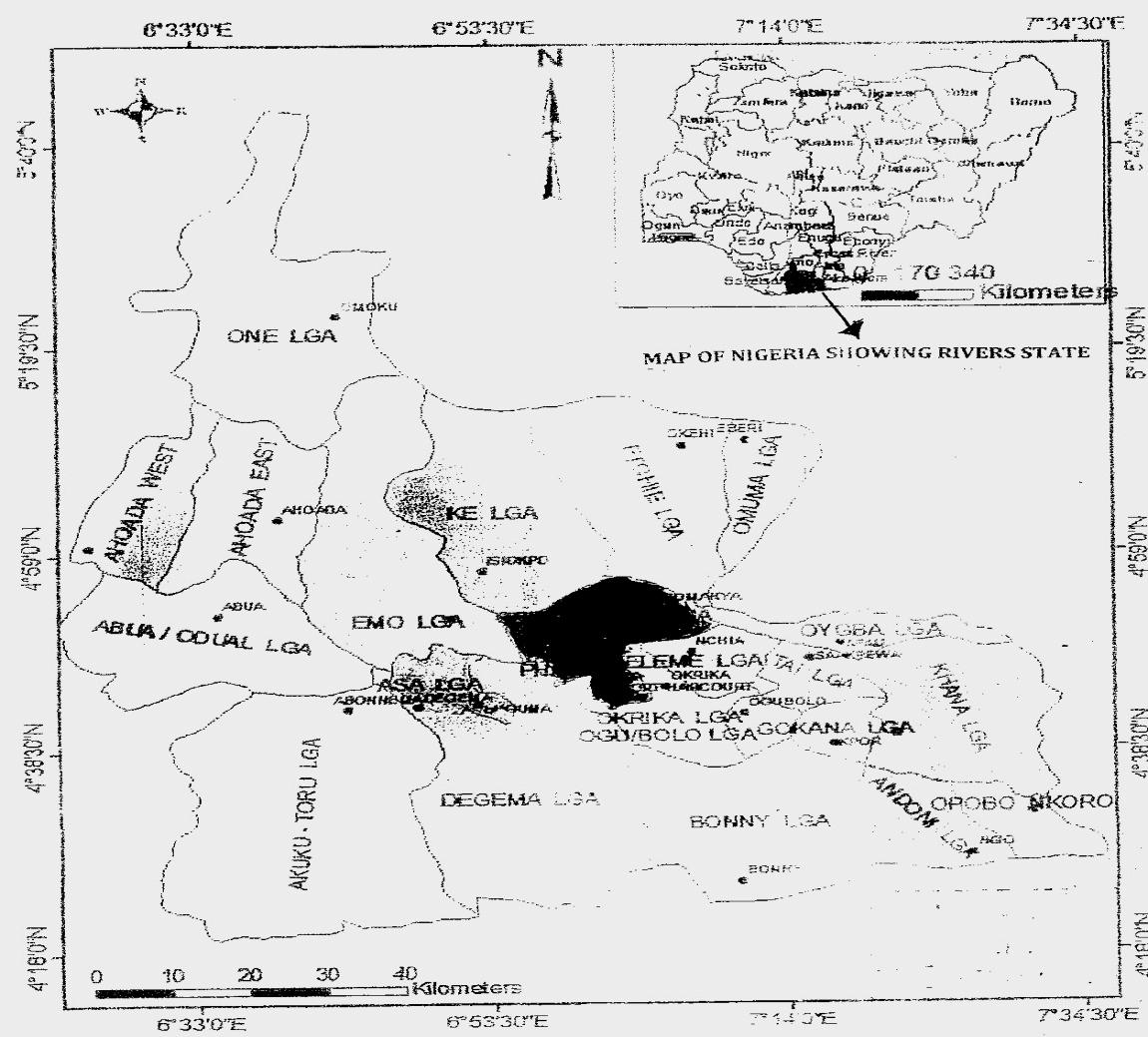 | Figure 1. Map of Rivers State showing Port Harcourt, the Garden City |
Power supply is almost not inexistence in the city. The rationing of electricity supply in the city means that private business has to depend largely on personal power generator to stay alive in the market. The story from the health sector is not a palatable one either. Doctors and nurses at the two major government owned hospitals had embarked on more strike than any other union in the state thereby often subjecting patients to the mercy of private hospitals whose fees the common man in the street cannot afford.The provision of such basic services as water supply to the public has been struck out from the list of government. Water supply to the public is now completely left in the hand of the private sector. The public taps that were clearly visible in the streets of the city, that gave water to the poor in the 70’s and 80’s had completely gone with history.Crime is still on the high side despite the presence of the Joint Military Task Force (JTF) on the streets. Though militancy war has decreased with the introduction of the federal government Amnesty programme, cult groups still operate with light weapons, attacking one another at will, and also making the street of Port-Harcourt still unsafe for residents at night.
2. Method and Technique
Port Harcourt, the administrative capital of Rivers State is one of the most industrialized cities in Nigeria. The city is divided along two zones; Northern and Southern Port Harcourt. While the northern part is largely made up of arable land, the southern part is largely made up of array of creeks. There are about four hundred and eighty three identifiable roads in the city. For the purpose of this study, the entire city was segmented into four zones; north, south, east and west using geographic characteristics. Three types of residential development were identified in the city; the indigenous settlements that had been swallowed up by the city through expansion but still maintain the indigenous names and landmarks, the planned residential areas that came with the city’s growth and the areas growing without any form of development control. In each of the zone, inventory of localities or settlements was compiled. Six localities were identified in each zone. A random sample of two localities was picked from each zone representing 33.3%. A further compilation of streets in each locality picked for the study was made. A systematic random sampling technique was used to administer 2000 structured questionnaires in eight selected localities in the city (table 6). In order to ensure effective distribution and representation, 30% of the total number of streets in each locality was randomly picked for questionnaire administration. A total of 250 questionnaires were evenly distributed within the selected streets in each locality. In each street, after the first building and first resident, an interval of 5 was used to select the next building and the next resident. Our target in each building is head of household who had resided in the city for a period of forty years and above. Relevant information were extracted from questionnaires and used for this sturdy. Personal observation and oral interview were also employed where necessary to achieve the aim of this research work. Officials of some government establishments involved in the provision basic services to the public were also identified and interviewed. The response level in all was very encouraging.
3. Historical Development of the City of Port Harcourt
What is today known as Port Harcourt was initially a farmland and secondary forest in the north called Obomuti by the Ikwerre indigenes who resides there [3]. The southern part of the land was occupied by army of creeks used by the Okrika fishermen as transit camps [4]. Due to its geographical location, the area became a meeting point for trade between the upland farmers from the Ikwerre, Ahoada, Abua and the fishermen from the riverine Okrika, Kalabari and Ibani. With the spread of colonial influence in Nigeria between 1912 and 1914, a seaport and railway line was located in the area. It became a route for the evacuation of agricultural produce and other minerals from Eastern and Northern Nigeria. This singular act increased the geographical significance of the area. In May, 1913, for the purpose of administrative convenience by the Colonial Masters, an agreement was reached between the Colonial Masters, the Ikwerre of the north and the Okrikas of the south. In this agreement called the Hargrove Agreement 30,000 acres of land was ceded to the Colonial Masters of which only 13,000 acres were suitable for physical development [3]. The name Port Harcourt was given to it by Lord Luggard, the first Governor General of Nigeria. It was named after the then British Secretary of State, Lewis Harcourt. This development increased the status of the area. It triggered off the migration of several European trading firms, traders, businessmen and government establishment into the area from different parts of the country. The area gradually metamorphosed into a strong commercial and administrative centre south of the country. Its seaport became an export route for such commodities as groundnuts and palm oil. With the discovery of oil in commercial quantity in the region, the young city provided more economic opportunities for persons from all over the country. This was the beginning of rapid migration into the area. With the creation of Rivers State from the former Eastern Region, the city became the capital of the new State. The city has recorded an astronomical growth since then spatially expanding beyond its original boundary. Initial growth was towards the southern axis surrounded by arrays of mangrove swamp. Today, land space here has been exhausted forcing developers to direct development towards the northern axis made up of arable land. With a population of over 1.5million, the city stands out as one of the fastest growing cities in the country both in commerce and human population [2]. The city is popularly referred to as the Garden City of Nigeria because of his richness in greenery.
4. Objectives of the Study
(i) To take a clinical study of the socio-economic life of the residents of one of the fastest growing cities in Nigeria.(ii) To provide information that will help the government formulate policies that will reduce the human misery in the city.(iii) To provide a proper picture of the problems facing residents of the city with a view of helping the government plan and design projects that will improve the productivity, income, welfare and other features of satisfactory life of residents of the city.(iv) To provide information that will help the government to address simultaneously the various dimensions of sustainable development of the city(v) To make appropriate recommendations in the face of existing problems confronting residents of the city.
5. The Traffic Situation in Port-Harcourt
There are three very important trunk A roads in the city of Port Harcourt; Port Harcourt- Aba Express Road, Ikwerre Road and the East-West Road. These roads take traffic into the neighbouring States of Abia, Imo and Bayelsa. They also stand out as “backbone of arteries from which ribs or lines of feeder roads run off into various directions in the city” [3] There are about four hundred and eighty three identifiable roads divided within the major classes of roads serving a population of 1.5million persons. With an ever astronomically increasing population and tremendous growth both in industry and commerce, the city stands as one of the busiest cities in Nigeria. This explains in part the congestion and terrifying traffic hold-ups experienced on some of the major roads especially at rush hours. This situation is made worse by the poor state of some of these roads. The government of Rotimi Ameachi had spent billions of Naira on road construction and expansion but the poor state of some of these major roads in the city; infested with deep potholes, explains that either there was no proper monitoring during construction or less quality materials were used by the government contractors. This conclusion is drawn from the fact that some of these roads were actually constructed or reconstructed in his tenure. Some had barely survived one rainy season. For instance, in the Borikiri axis of the main Port Harcourt township spanning from the Coronation layout to Igbukulu end of Borikiri, close to 50% of the roads are in bad condition (table 1).Table 1. Condition of Roads in Borikiri Axis of Main Port Harcourt Township
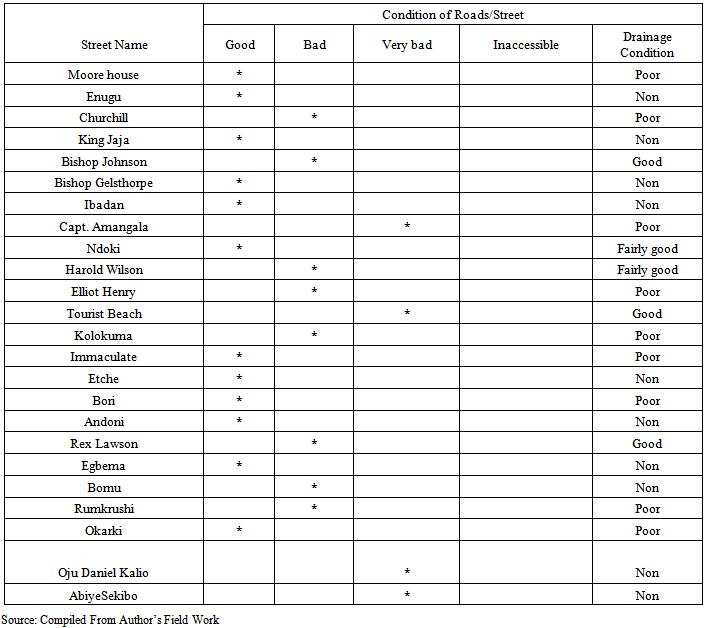 |
| |
|
The picture is not different in the Diobu axis of the city where more than 50% of the roads are in bad shape (table 2). The absence good drainage along some of these roads makes driving immediately after heavy rainfall even more difficult thus resulting into notorious traffic hold-ups. The implication of this is an increase in travel-time within the city (table 3). The degree of hold-up in some of these roads is so frustrating that residents have no choice but to leave their homes before the break of day if children have to meet up classes, if workers have to get to their offices before resumption time.Table 2. Condition of Roads in Diobu Area of the City
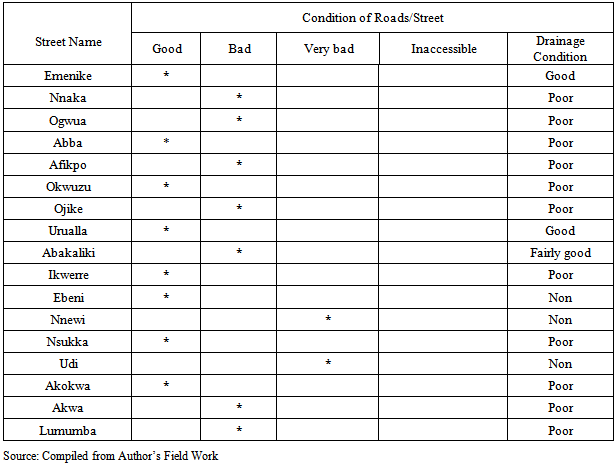 |
| |
|
Table 3. Travel Time between Some Selected Areas in Port Harcourt(with private vehicle)
 |
| |
|
In the evening rush hours, two options are open to residents plying such roads; to leave the office before closing time in order to beat the hold-up hours or find somewhere to hang around at the close of work or business until the hold-up clears out. In some areas of the city, the hold-up could last up to 8pm in the night.
6. Power Supply in Port Harcourt
Electricity supply in the city of Port-Harcourtis at its lowest ebb in the last eight years. Despite the billions spent by the government to help the Power Holding Company (now Port-Harcourt City Electricity Distribution Company) no significant improvement had been recorded in power supply to the city. Residents have been made to depend largely on private power plant to keep business going or give the home some comfort after the day’s work. This has not only affected running cost in business but has also resulted into high cost of goods and services in the city. In some parts of the city especially in the northern axis, power supply can go off for as long as one to three months for what the electricity officials usually refer to as “major fault”, forcing residents to depend solely on private generators. This pain is further compounded by the exorbitant monthly bills posted to residents of the city by the power distribution company. In a survey randomly conducted among 300 electricity consumers across the city using analogue electricity meters, 70% agreed that most often readings posted on their bills do not tally with actual reading on the electricity meter. They concluded that charges by the Electricity Company most times are based on estimated consumption leaving the consumer with a high bill to settle at the end of the month. A one-bedroom apartment in the medium density areas could be charged between ten thousand naira and twenty thousand naira a month based on estimated consumption. Ownership of electricity generator is no more a luxury but a necessity in the city. Those affected most by this epileptic power supply are those in the small scale business sector. Those who could not afford to fuel their private electricity generator regularly have two options; close their businesses or change their line of business to that which does not require electricity consumption.Table 4. Daily Power Supply in Some Selected Areasin Port Harcourt
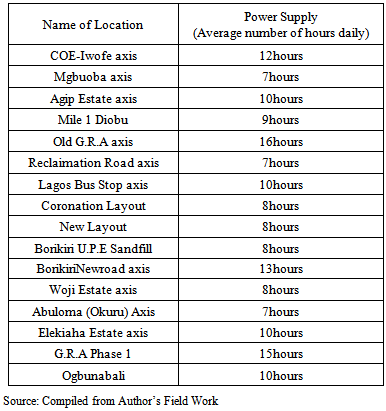 |
| |
|
7. Health Services in Port Harcourt
Dr. Sampson Parker, the Rivers State Commissioner for health had boasted that the present government had spentalmost100 Billion Naira on the health sector [5]. This claim was made at an event to mark the appreciation of ophthalmologist from U.S based hospital for humanity who in collaboration with Rivers State government carried out a free surgery for glaucoma and cataract patients in Port Harcourt. Even though the Hon. Commissioner did not provide any documented evidence to back up his claims, one thing we cannot deny is the fact that the government of Ameachi has performed more than any other administration in the state in the provision of health facilities. By September, 2013, his government had completed almost 150 health centres scattered across the state. His government also recruited several doctors and nurses to strengthen the health sector [5]. Despite the billions the governor claimed to have spent on the health sector, doctors at the State government owned hospital and health centres had embarked on more strike than any other union in the state. The story at the federal government owned University of Port Harcourt Teaching Hospital (UPTH) is not different. Some residents of the city interviewed stated that they had lost count on the number of times resident doctors at the UPTH had gone on strike in the last two years. By the middle of February, 2014, the Resident doctors had commenced another chain of strike attributed to unpaid salaries and illegal deductions from their salaries and allowances. At this time, doctors at the state owned Braithwaite Memorial Hospital were already on a week old strike. Their own reason was that the state government has not responded positively to the challenges confronting them in their working environment. This incessant strike by doctors had often left patients at the mercy of private hospitals whose bills the ordinary man in the city cannot pay. Last year alone medical services at the state government owned hospital and health centres were brought to a standstill by striking doctors three times. Besides the issue of allowances and salaries, the doctors had complained that the government has failed to meet the challenges confronting them. They had claimed that public health services available to the poor in the state had collapsed completely. According to them for more than one year the government had refused to pay the bills submitted for “free medical” services which the PDP government had introduced in the state. The Emergency Medical Services they claimed had also been operating on a zero allocation close to one year. A visit to the Radiology department shows that most of the equipment had long ceased to function. The hospital could not even pay for consumables forcing most head of department to stay away from their offices to avoid the wrath of suppliers’ owed huge amount of money. As one medical staff summarily puts it “the hospital is very broke, it cannot even fuel its electricity generator” The situation at the public health centres is not different. The collapse in the public health sector is a plus to the operators of private hospitals and clinics in the city. Residents have no choice but to turn to the private health sector whose bills are always on the high side for their health needs. For those who could not afford the exorbitant fees charged by the private hospitals, the traditional herbal clinics had always been their final bus stop. As at the end of February, 2014, the only public health institution operating at full capacity in the city was the newly built Rivers State government owned Kelsey Harrison Memorial Hospital but the outrageous fees charged shows that it is only meant for the rich. An intermediate case charged seventy two thousand naira at the BMH goes for about two hundred thousand naira at the Kelsey Memorial Hospital. Residents of the city are complaining that except you are recommended by a “big boy” of the ruling government, you will be turned back from the gate with the usual excuse “no free bed space”. Residents of the city has tagged the hospital as ‘’ hospital for the big boys, their families and friends”. Here it was observed that “free medical” bills are cleared every two weeks by the government.
8. Water Supply in the City
Water supply in the city has been completely left in the hand of the private sector. The streets of Port Harcourt are infested with private boreholes whose quality cannot be guaranteed with any degree of confidence. The public taps available in the 70’s and 80’s had completely disappeared in the city. The government has no explanation to the people why it cannot provide water for the residents of the city. While it is making money from private borehole operators through tax, no concrete effort is made to control water quality. Every street in the high and medium density areas of the city has an average of three commercial boreholes. An average household of seven persons spent an average of five hundred naira a week on water from private boreholes (table 5).Table 5. Cost of Domestic Water Consumption from Private Boreholes by Households
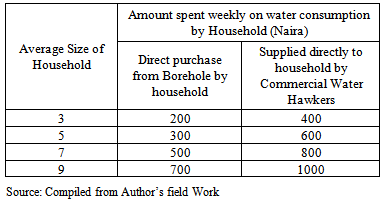 |
| |
|
The situation is made worse by the fact that, water supplied by a greater percentage of these private boreholes cannot qualify as ‘good drinking water’ which mean residents have to depend greatly on the popular sachet water which goes for a hundred naira per bag of 20 sachets as a major source of drinking water. Even though the sachet water goes by the name ‘pure water’, the purity of such water is often times in doubt. The government does not have a full track of the actual number of firms producing sachet water in the city. Beside the few registered firms with the government, a number of small scale illegal firms exist in some residential homes unknown to the government. Due to the lucrative nature of the business coupled with the little capital needed to take-off, some jobless youths have found a heaven in the business. Some residents of the city that had had bitter experiences from the consumption of ‘pure water’ simply refer to it as ‘packaged typhoid’ for sale. A simple random sample of 250 households each in eight different locations in the city revealed the following results as it relates to source of drinking water (table 6).Table 6. Main Source of Drinking Water in some Selected Households in Port Harcourt
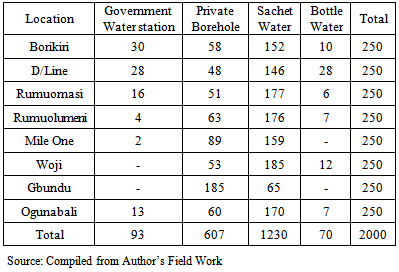 |
| |
|
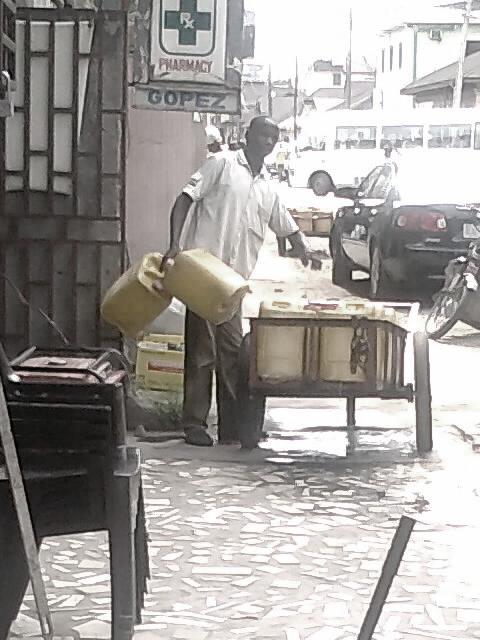 | Figure 2. Commercial Water Hawkerin the City of Port Harcourt |
9. Security Situation in the City
The current Amnesty Programme in its fourth year running has brought relative peace to the city of Port Harcourt. The militant groups divided along two lines; Ateke Tom and Asari Dokubo, who once made the streets of the city unsafe for residents, had dropped their arms and embraced the carrots of Amnesty. However pockets of cult groups under their own local leaders still exist, occasionally terrorizing residents despite the presence of the Joint Military Task Force (JTF) on the streets of the city. Most of them are school dropouts and jobless youths that were used to making money during the militancy crises through the activities of oil bunkering under their Masters. The desire to survive has made these boys to continue with criminality since the military is winning the war against oil theft in the Niger Delta. There is still the availability of small arms among these groups which are used occasionally for their criminal operations. It was reported that on the 28thof February 2014, a youth leader of Azubie in the heart of the city was senselessly killed. Barely two days later, predecessor to the slain youth leader was also gunned down by unknown gunmen in the same Azubie [6]. That same evening, 2nd of March 2014, a serving Councilor with the Akoku-Toru Council of Rivers State, Sotonye George will was assassinated at Accra Street in the main Port Harcourt Township. Kidnapping is still a profitable business in the city. On the 26th of February, three chieftains of the People Democratic Party were kidnapped from their homes in Eagle Island by unknown gunmen. By the middle of March the police had recorded two additional cases of kidnapping; a young man from Rumuowoji Community, north of the city and a popular radio broadcaster with Wazobia FM. Night life in some sections of the city is still at the lowest ebb, gates are still shut as early as 7pm and shops don’t stay beyond 8pm [7]. On the major streets of the city during working hours, it is common to see these boys organizing themselves into illegal revenue Task Force harassing motorist and collecting all manner of fees from them. There are about twenty five of such illegal groups operating under the cover of the local or state government with different names in the city. Shop owners in some areas are forced to pay security fee to these boys every month. The heating of the polity of the state by the PDP and APC ahead of the 2015 general election is gradually raising the profile of these boys. It is obvious that both camps are going to depend greatly on their foot soldiers to pursue their 2015 political agenda.
10. Housing Situation in the City
One of the horrifying nightmares that took over the city of Port Harcourt from the 80’s was ‘Housing Famine’. The available economic opportunities in the city made it a heaven for people from different parts of the country. The daily increase in the city’s population coupled with the slow pace of replacement and refurbishment of obsolete stock has resulted into high rent in both residential and commercial accommodation [8]. The worst hit is the low income. Accommodation presently in the planned residential areas is almost impossible for the low income (table 7). This explains the reason for the astronomical development of residential units on marginal land at the periphery of the city [2]. With a government that is ready to do little or nothing in the provision of low income housing, marginal lands have become a heaven for the low income. Here raising a ‘home’ for habitation is cheaper, cost of accommodation is also on the low side. Today there are about thirty two marginal settlements in the city with a population of about 200,000-500,000 persons [2, 9].These marginal settlements have added their own nightmare to the city. These settlements which are largely inhabited by the low income with very poor environmental, social and economic conditions have become a breeding ground for criminals and cult activities [2]. Because of the strategic importance of the settlements in the business of oil bunkering, cult war among the various cult groups are unending in these settlements. Such wars are frequently fuelled by the desire to establish control over the settlements by the different groups. Table 7. Cost of Rental Residential Accommodation (per annum) in the Medium Density Areas of Port Harcourt, Owerri and Aba
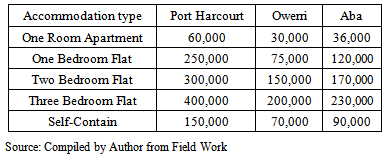 |
| |
|
The government response was to apply the instrument of ‘total clearance and redevelopment’ of all marginal lands. Though the bulldozer of Governor Ameachi succeeded in bringing down two marginal settlements south of the city, ethnic forces from the riverine area of the state fought against the governor’s bulldozer from further demolition. 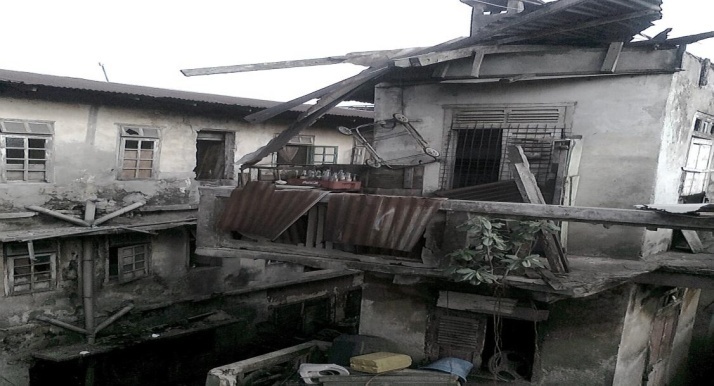 | Figure 3. Insanitary Residential Units Inhabited by the Low Income in the City: The pains of Housing Famine in the City |
11. Implication of Findings
The inability of the government to provide adequate security for lives and properties in the city means that residents have to take some extra steps to secure their lives and properties. Families living in rented apartment have to spend extra from their pocket to provide extra security cover for their household. Firms operating in the city have to spend extra outside their original operating cost to secure the lives of their staff and properties of their firms. The cost is even higher for those having the services of expatriate in their work force as it has become mandatory for such expatriate to move around the city on military escort. The inability of shop owners to open their doors in the evening for fear of being robbed is a minus not only to the business owners but also to the economy of the city. The economic implication is even more on the high side for those businesses that usually enjoy high patronage in the evening hours. The general implication is that those who are not able to square up to the security challenges in the city will be forced to relocate to other cities that are safer for their line of business to operate or families to dwell. Secondly, new business opportunities will shy away from the city.The city has suddenly become a heaven for private hospitals and clinics springing up every day at every corner. The quality of their work force and level of services rendered to the public by some of these private clinics and hospitals puts a big question mark on “standard”. The absence of a quality, functional and well organized public health system to meet up the health challenges of the public has left residents with no choice but to keep patronizing these private medical homes in the city. The number of residents that troops out to patronize the traditional herbalist in each of their “trade fair” in the city has a lot to explain to us about the inadequacy of our public health delivery system. Recently in the city, a serving Senator was hit by a rubber bullet and was immediately flown abroad for treatment. Several questions had followed this decision bothering on the state of the public health institutions in the city. The underlying implicating of this picture is clear to every one; high death rate in the city.The epileptic public power supply in the city means businesses have to depend largely on private electricity generating plant to stay alive in business. This is not a plus for firms operating in the city. High running cost in the production of goods and services also means that consumers have to pay more to access such goods and services. This explains the reason why the city is gradually turning out to be the most expensive city to dwell and do business in Nigeria. The worst hit is the medium and low scale business brackets whose services depend largely on electricity supply. For those in these brackets, staying alive in business with private generator coupled with high cost of business space and unending multiple taxation from the state and local government (a common trait in the city), is like climbing a mountain. Thus, for those who could not meet up, the option is to fold up and join the unemployment queue or look for another trade. This will not be palatable for a government that is yet to fully win the war against criminality and militancy, a government that is preaching entrepreneurship among its army of unemployed youths.When the Governor of the State rolled out his bulldozer to bring down two marginal settlement; Abonema wharf and Nzemenze, he had told the residents of the city that he was going to raise a well planned low cost housing estate in its place for the low income. That project is yet to start four years after the governor’s declaration. This failure on the part of the government summarily represents the attitude of the government in low income housing provision. The government of the State in the last 16years cannot boast of any tangible success in the area of low income housing provision. Thus one of the masquerading problems confronting the city today is “housing famine”. The few efforts made by the government of Peter Odili and Rotimi Ameachi were in favour of the high income. With housing provision completely left in the hand of the private sector whose desire is to make profit, house rent will continue to soar higher into the sky occasioned by scarcity in residential and commercial accommodation. This means that the low income will continually be shuffled out of the planned residential areas of the city where rent is daily climbing into the heavens. The implication is that more marginal settlements will emerge in the city since it offers to the low income ‘a roof over head’. This by extension also means that government war against crime cannot be won knowing the evils associated with the existing marginal settlements in the city.In the 70’s and 80’s, the primary source of drinking water in Port Harcourt was the government water pipes that ran through the streets of the city. Today while the pumping stations that supplied the water in the 70’s and 80’s are still standing, the pipes had all gone dry. The explanation of the present government was that it was having some difficulties accessing World Bank loan needed to activate its pumping stations and provide water for the people. While residents wait for the time the government will make good its promise of providing water to the people, death and sicknesses arising from water related disease will continue to be one of the nightmares of the city.
12. Conclusions and Recommendations
Port Harcourt is an economically viable city. Its population is still rising daily despite the fact that the land space accommodating the city has been over-stretched. Adequate planning on the part of the government for its present and future population is therefore essential if we are to prevent further chaos in the city. Failure to plan effectively will mean that facilities and infrastructure will be over-stretched to a point of breakdown thereby giving to the public and government more horrifying nightmares. To achieve sustainable development in the city, the government should maintain and upgrade existing facilities that has direct bearing on the socio-economic life of the residents of the city. The supply of safe drinking water will help to raise the welfare of residents of the city. It is appalling to note that the non-functionality of the government pumping stations is responsible for the dryness of public pipes in the city. Past studies had revealed that “water related diseases account for estimated 10% of each person’s working life” [10].The provision of safe drinking water will no doubt decrease the incident of these diseases. It is appalling to know that about 61% and 30% of the sampled household depend on the popular sachet water manufacturer and private borehole operator respectively for their drinking water. This is a danger signal to a government that has been singing the gospel of total health delivery for the masses. Putting back to life the existing ‘pumping stations’ will ensure that safe water runs into residential homes. In addition, the government should also take the extra steps of building new water stations since the capacity of the old ones were not meant to serve the present population. Bringing the private sector in the form of partnership into the running and management of the government public water scheme will also be helpful.Governor Ameachi had boasted that “ Rivers State has sufficient power, what we don’t have is distribution” [11].The State government should liaise with the federal government for the necessary technical and technological assistance for effective power distribution so that the city does not continue to drive investors away or close down more small scale businesses. The erection of beautiful edifice as hospitals and health centres is very much appreciated but it should be realized that this action alone does not promote good health. The picture of over crowding experience daily at government hospitals and health centres is an indication that both the available public health facilities and personnel are not adequate for the population of the city. The state government should upgrade the health centres in the city to make them more functional. The provision of more medical personnel and advanced medical equipment will help these health centres take up more challenging health task. Patients most often at the government health centres are left at the mercy of nurses especially at night. Provision of residential accommodation within the premises of the health centres for medical personnel will also help greatly. The situation were some of the staff working at the government owned hospitals have been on the payroll of the hospitals as ‘casual workers’ for more than three years or where doctors are often times not available to patients at night at the government health centres does not give any high grade to a government that says it is ready to tackle the health challenges of its people.The police in the city should realize that patrolling the streets every minute with siren at its highest volume does not solve the problem of criminality in the city. The number of police patrol vehicles that runs through the city is higher in the day than in the night. The story is also the same for police check points. The fact that criminal activities are on the higher side in the night hours places a question mark on the sincerity of the police to stop crime in the city. The police should also realize that the criminals live among the peoples and are known by their neighbours but nobody wants to report the matter because the police cannot be trusted; the police do not have adequate protective cover for informants. For the police to record adequate success in the fight against crime, it must be ready to protect and reward informants secretly. Secondly, the police should increase the number of check points at night along the major streets in the city. The number of police vehicles patrolling the streets at night should also be increased. Criminals caught or handed over to the police by members of the public should be prosecuted and punished immediately. The situation where criminals arrested, disappear and re-appear in the street after a short while does not tell a good story of the police. Demolition of marginal settlements in the city as a way of checking criminality without redeveloping such settlements is not only an indirect way of bringing forth more severe ‘housing famine’ in the city but also generating more social and economic problems. Since the government had failed in its responsibility of housing provision for the low income, marginal settlements should be allowed to remain. What the government needs to do is to provide some basic urban infrastructure and introduce some element of development control into the settlements. The provision of safe water, health services, educational facilities, recreational centres etc. will bring some measure of life into the settlements. Public housing provision for the low and medium income should not be neglected by the government. Availability of housing loan to workers in the public service on the part of the state government will help to give some measure of relief to the problem of ‘housing famine’ in the city. As a long term measure towards decongesting the city, the government thinking should gradually be tailored towards the development of other urban centres in the state to serve as secondary cities. One area perhaps in which further research is necessary is on the benefit of developing secondary cities in Rivers State.
References
| [1] | National Population Commission, Abuja, Nigeria. |
| [2] | Kio-Lawson, D “Marginal Settlement in Port Harcourt, the Garden City: The Geography of Horror” Scientific and Academic Publishing, vol. 3,no.3 World Environment pp77-84, 2013. |
| [3] | Akpogemeh O.S “A Guide to Port Harcourt Metropolis and its Environment” Kraft Books Limited, Ibadan, Nigeria, 1995. |
| [4] | Okafor, S.O. “The Port Harcourt Issue: A note on Dr Tamuno’s Article (PDF): African Affairs. Royal African Society, Oxford University Press 72(286):74,1973. |
| [5] | OnlineAvailable:www.thisdaylive.com/article/ameachi-deploy-n100billion-to-free-health-care/15994/ |
| [6] | Chris,K. and Blessing, I “Kidnapping, Killing on the Increase in Rivers State” National Network, Nigeria,vol.11,no. 8 pp2,2014. |
| [7] | Matilda, E “Hoodlums Invade Amadi-Ama community; Cart Away Valuables” Weekly Star, Nigeria vol. 16, no.03. pp 4, Jan.2014. |
| [8] | Obinna V.C “Housing in Nigerian Policy Aspect” King Jovic International Publishers, Port Harcourt, Nigeria, 2008. |
| [9] | Online Available:http://forum-habitat.org/site/en/port-harcourt |
| [10] | WQI. “Water Sanitation: Earth Summit Priorities. Water Quality International (4) 24-26,1991. |
| [11] | Online Available: http//nddc.gov.ng/news_id1f.html |




 Abstract
Abstract Reference
Reference Full-Text PDF
Full-Text PDF Full-text HTML
Full-text HTML





